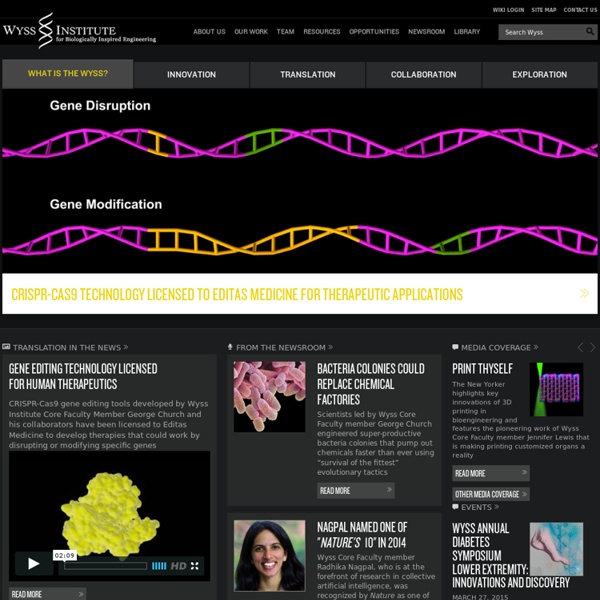



Ask Nature - the Biomimicry Design Portal: biomimetics, architecture, biology, innovation inspired by nature, industrial design - Ask Nature - the Biomimicry Design Portal: biomimetics, architecture, biology, innovation inspired by nature, industrial desi Proof Daley Lab Art and Science Shannon and Patrick get the cover of Cell Stem Cell! Please see: "The transcriptional landscape of hematopoietic stem cell ontogeny", McKinney-Freeman S, Cahan P, Li H, Lacadie SA, Huang HT, Curran M, Loewer S, Naveiras O, Kathrein KL, Konantz M, Langdon EM, Lengerke C, Zon LI, Collins JJ, Daley GQ. Cell Stem Cell. 2012 Nov 2;11(5):701-14.. (go to PubMed) Ms. "World Cells" by Ms. Ms. The Samurai warrior, Miyamoto Musashi. View of Boston from the 7th Floor of the Karp Building at Children's Hospital Boston Copyright Anna J. Research laboratory bay in the Karp Builing at Children's Hospital Boston Copyright Anna J. George working out some science at the white board. Alex, a technician in Thorsten Schlaeger's lab. An abstract representation of looking down into a laboratory hazardous waste bin. ‘The new building blocks of cell biology’, a watercolour by Anna J. Please see: "The new building blocks of cell biology", Lensch AJ, Trends Cell Biol. 2010 Dec;20(12):cover image.
Shattered chromosome cures woman of immune disease Call it a scientific oddity—or a medical miracle. A girl who grew up with a serious genetic immune disease was apparently cured in her 30s by one of her chromosomes shattering into pieces and reassembling. Scientists traced the woman’s improvement to the removal of a harmful gene through this scrambling of DNA in one of her blood stem cells—a recently identified phenomenon that until now had only been linked to cancer. The woman, who lives in Cincinnati, Ohio, suffered from recurring bacterial infections as a child. In 2003, researchers linked WHIM to a gene called CXCR4, which codes for a cell surface protein that immune cells use to recognize chemical messengers called chemokines. Murphy and colleagues have studied WHIM patients at the National Institutes of Health’s (NIH’s) Clinical Center to better understand the disease and develop a possible treatment with a drug that inhibits CXCR4. The woman was that first WHIM patient, now 59 years old. The NIH team began sleuthing.
Eco | Interface | Mind the Gap Cluster | City - Design - Innovation Where Science And Art Collide This is a guest post by Susana Simões Pereira. Have you ever heard of using dance to study science, as, for instance, cells movements? Well, John Bohannon has. Actually, he recently presented his “Dance Your PhD” project at TEDxBrussels, which aims to use dance as a way to study and communicate science efficiently. But using art as a mean to communicate science to scientists and non-scientists, kids and adults, is the intent of some other interesting projects like “The love motel for Insects” at NYC. This project, “brought to life” by Brandon Ballengée, allows people to contact and learn about arthropods lives while enjoying themselves. Another kind of SciArt project is developed by Luke Jerram. These are some of many examples that show learning science can be indeed fun and take place in very different contexts from the ones we’re used to. Susana Simões Pereira is a Portuguese mathematician and PhD student in Science Communication.
Research team edits the DNA of fertilized human embryos For several weeks, rumors have been circulating that a research group in China had performed the first targeted editing of DNA in human embryos. Today, the rumors were confirmed by the appearance of a paper in the journal Protein & Cell, describing genome editing performed at Sun Yat-sen University in Guangzhou, China. The paper shows that while the technique can work, it doesn't work very efficiently, suggesting there are a lot of hurdles between existing techniques and widespread genetic engineering of humanity. To avoid potential ethical issues, the researchers performed their experiments with embryos that had been fertilized by more than one sperm. While these are regular occurrences in in vitro fertilization procedures, the embryos are inviable and normally discarded. The work relied on the CRISPR-Cas9 system. This has worked in a variety of systems, and the authors confirmed that it works with their gene of choice: the hemoglobin component β-globin.
Biomimicry Education Network Process Compendium 2004-2010 by C.E.B @Reas [#Processing] Process Compendium 2004-2010 is a collection of work and record of process by Casey Reas, co-founder of Processing, presented and created entirely in Processing. If you have seen Casey speak, this is another opportunity to examine and explore generative art Casey has been creating in the past few years. If you haven’t, (must) download links below. Spoken by computer voice, you are taken on a journey by Casey through conditions, rules and elements that play a part in the creation of prints, sculptures Casey exhibited worldwide. From early examples of attributed behaviour to simple objects such as lines and circles to complex traces and colour trails these objects create, all resulting in beautiful compositions, captured as fragments of time. An Element is a simple machine that is comprised of a Form and one or more Behaviors. Download: Mac | Windows For more work, see reas.com
Hunter Cole - Artist and Scientist